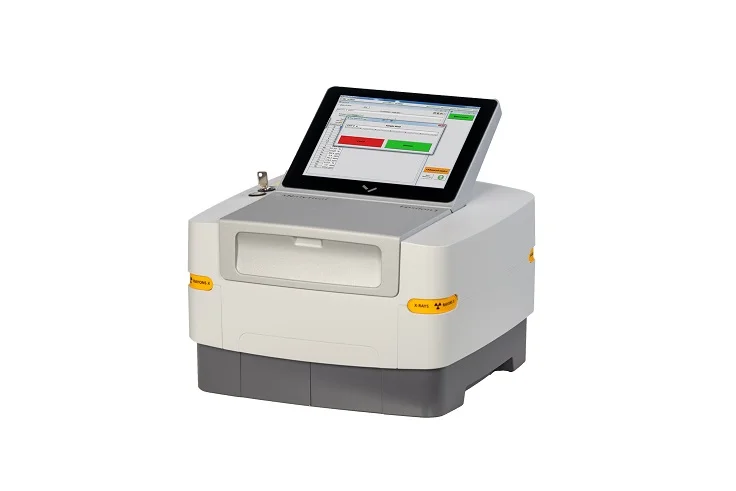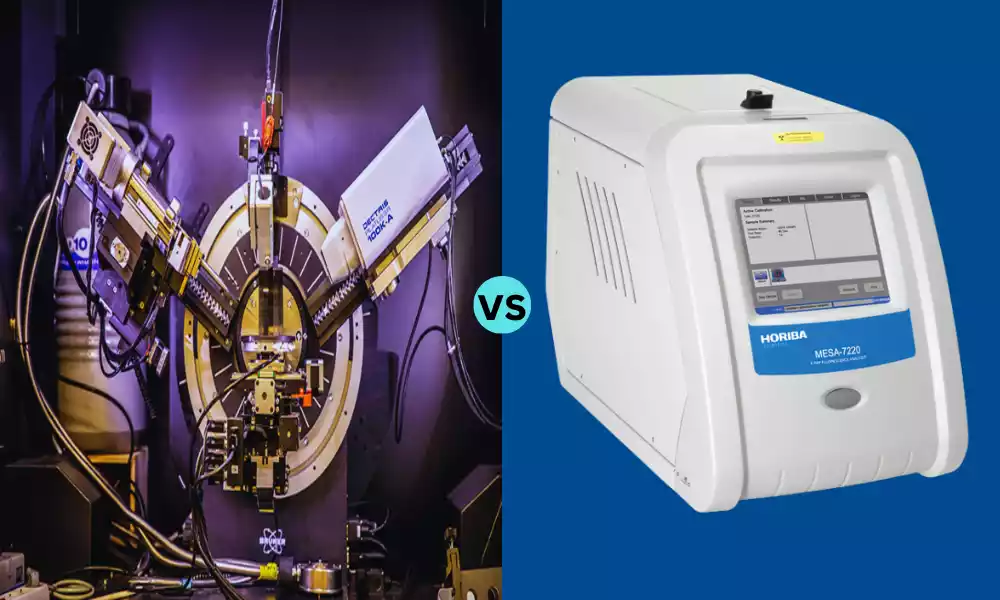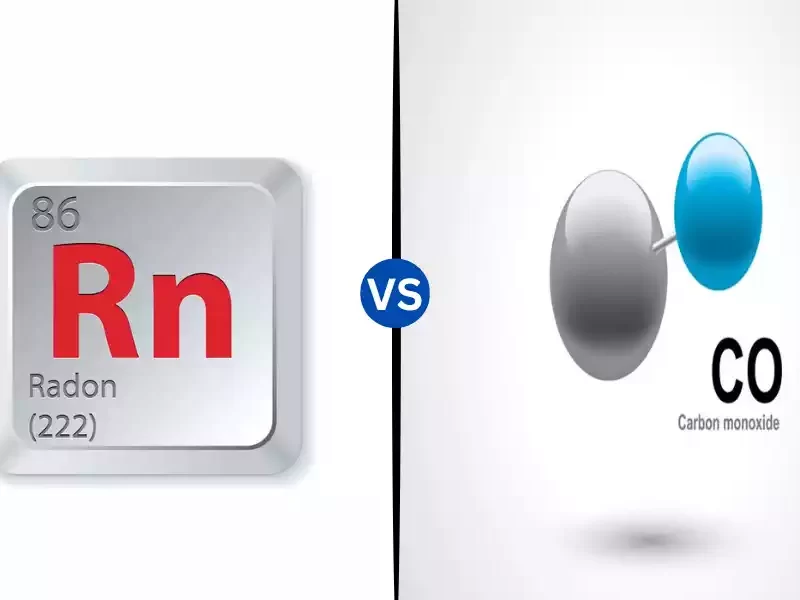X-ray Diffraction and X-ray Fluorescence are both analytical techniques that utilize X-rays for material characterization. XRD focuses on studying the arrangement of atoms in crystalline structures, while XRF is used for elemental analysis in various materials.
X-ray Diffraction (XRD) is like a superhero flashlight revealing the tiny structures of things, such as crystals, by studying how special light (X-rays) bounces off them. On the other hand, X-ray Fluorescence (XRF) is akin to a magical flashlight that makes objects glow in different colors, helping scientists identify the elements present, much like recognizing ingredients in a recipe.
XRD uncovers shapes, akin to shadows cast by a flashlight, while XRF unveils the elemental composition, acting like a magical flashlight revealing the hidden ingredients in everyday items. Both techniques are powerful tools for scientists exploring the secrets of the miniature world.
What is X-ray Diffraction?
X-ray Diffraction is like using a special flashlight to look at really tiny things, such as crystals or small particles. Imagine shining this unique light (X-rays) on an object, it bounces off in specific ways, creating a pattern.

Scientists study this pattern to understand how the tiny pieces of things are arranged, like figuring out the design of a puzzle. It helps them learn about the structure of materials on a super tiny scale, almost like using a secret light to reveal the hidden details of the tiniest building blocks in the world.
What is X-ray Fluorescence?
X-ray Fluorescence is like having a magical flashlight that, when you shine it on something, makes it light up with different colors. Each color tells you about specific elements, like the ingredients in a recipe. Scientists use this special flashlight to find out what elements are in different things, like rocks or toys.

It’s like a fun way of discovering the hidden secrets of stuff by seeing which colors appear when you shine the magical light on them. So, X-ray Fluorescence helps scientists learn what things are made of by using this colorful light to uncover the elements inside them.
Importance of X-ray Diffraction (XRD) and X-ray Fluorescence (XRF)
Importance of X-ray Diffraction (XRD):
- Structural Analysis The XRD technique is essential for knowing the state of matter within crystal materials. It assists scientists in determining crystal structures and provides insight into the organization and geometry of molecules. This is essential for fields such as chemistry, material science, and geology.
- Phase identification: It is employed to distinguish different phases within an object, and distinguish between different crystal structures found. This is essential to ensure the quality of manufacturing processes as well as to ensure the quality of materials used in a variety of uses.
- Material Characterization The XRD process plays an important part in the characterization of materials by helping researchers evaluate their properties, including thermal stability, mechanical strength as well and electronic behavior. This data is essential to design and engineering advanced materials.
- Drug development: In pharmaceuticals, XRD plays a crucial role in determining the crystal structure of drugs. This is crucial to determine their stability, bioavailability and therapeutic properties, which contribute to the formulation and development of drugs.
Importance of X-ray Fluorescence (XRF):
- Elemental Analysis: It is a highly effective instrument for analyzing the elemental composition of diverse materials. It assists in identifying and quantifying the elements in a specimen, which aids in the study of different materials in various industries.
- Quality Control: In industry and manufacturing, XRF is employed for quality control reasons. It makes sure that the products and materials meet certain elements, thereby contributing to the creation of consistent and dependable products.
- Mining and Exploration: XRF is widely used by mining companies to provide fast and non-destructive examination of mineral samples. It permits quick analysis of concentrations of minerals, which aids in the exploration of the resources and improving extraction processes.
- Environmental Monitoring: The XRF technology is extremely useful for environmental science. It allows researchers to study soil or water samples for trace elements. This helps in monitoring pollution and ensuring compliance with environmental regulations.
- Archaeological as well as Art Conservation: XRF is used in the research of materials from the cultural heritage field. It assists in identifying pigments in artifacts, studying archaeological artifacts and examining the structure of objects from the past, and aids in preservation efforts.
Difference Between X-ray Diffraction and X-ray Fluorescence
Here’s a concise comparison chart for X-ray Diffraction (XRD) and X-ray Fluorescence (XRF):
| Aspect | X-ray Diffraction (XRD) | X-ray Fluorescence (XRF) |
|---|---|---|
| Principle | Bounces X-rays off crystal structures | Measures emitted X-rays from excited atoms |
| Purpose | Analyzes microscopic crystal organization | Determines elemental composition |
| Application | Material science, crystallography, geology | Mining, environmental science, archaeology |
| Information Obtained | Crystal symmetry, lattice parameters, interatomic distances | Elemental composition |
| Sample Interaction | Diffraction patterns from crystal lattice | Emission of X-rays after sample excitation |
| Sample Type | Requires crystalline samples | Analyzes various sample types (solids, liquids, powders) |
| Depth of Analysis | Provides information about crystal layers | Primarily surface-sensitive, limited depth information |
| Analysis Speed | Can be time-consuming | Rapid analysis, suitable for high-throughput applications |
| Equipment Complexity | Sophisticated equipment needed | Portable and handheld instruments are available |
| Versatility | Limited to crystalline materials | Versatile, applicable to a broad range of materials |
How does X-ray Diffraction and X-ray Fluorescence work?
(XRD):
Imagine shining a super-powered flashlight (X-rays) on a small castle constructed from building blocks (crystals). When the light hits the castle it scatters in many directions, forming an image.
Scientists make use of this pattern, similar to shadows, to determine the manner in which each of the blocks is placed within the castle. It’s similar to studying patterns of reflections in light to comprehend the structure of tiny objects, like particles or crystals.
“X-ray Fluorescence” (XRF):
Picture an amazing X-ray flashlight that is sprayed on objects, causing them to sparkle with different hues. Each color is a particular ingredient, similar to colors used in recipes.
Scientists utilize this unique light to determine the elements present in various objects by observing the colors that show up. It’s like using a bright flashlight to reveal the ingredients hidden in the materials they use, allowing scientists to find and quantify elements in toys, rocks, or other objects.
The Science behind X-ray Diffraction as well as X-ray Fluorescence?
X-ray Diffraction (XRD):
Imagine the X-rays as invisible beams of light. When you shine these beams of X-rays on a crystal reflect off the molecules within the crystal, forming patterns similar to ripples on water. These patterns are similar to fingerprints, which are unique to every crystal.
Scientists research these patterns to learn how the atoms are placed within the crystal. It’s similar to using X-ray beams to create a unique image of the invisibility in tiny objects, enabling us to discover their shape.
X-ray Fluorescence (XRF):
Imagine XRF as magical paint that lights up when struck by the X-rays. When we project X-rays onto an object, they trigger the atoms within it and emit a rainbow of light. Each color represents an individual element, much like the colors of the rainbow.
Through taking a look at these colors scientists can identify the elements that are present in the substance. The result is a magic color code that lets us understand what the material is made up of, which is an exciting way to look for the hidden ingredients that are found in everyday items.
Uses of X-ray Diffraction and X-ray Fluorescence
X-ray Diffraction (XRD):
- Crystallography: The study of the structure of atoms in crystals.
- Material Characterization: analyzes the properties of stability, structure, and mechanical behavior.
- Phase Identification: Different phases are identified in materials to ensure quality control.
- Pharmaceuticals: Determines drug crystal structures for drug development.
X-ray Fluorescence (XRF):
- Elemental Analysis: Determines the quantity and type of elements that are present in different materials.
- Quality Control: It ensures the consistency and quality of production by confirming the composition of elements.
- Exploration and Mining Exploration: Rapid analysis of samples of ore to explore the potential of resources.
- Environmental Monitoring: Examines soil, air, and water samples for trace elements.
- Archaeology as well as Art Conservation: Identifies the presence of pigments in artworks and analyzes the authenticity of artifacts from the past.
How Does X-ray Diffraction differ from X-ray Fluorescence?
Principle:
- The X-ray Difference (XRD): Involves the bouncing of X-rays from crystal structures to study their arrangement.
- X-ray Fluorescence (XRF): Measures the X-rays that a substance emits when it is excited by X-rays. This allows you to determine the presence of elements.
Purpose:
- The term “XRD”: Examines the microscopic structure of crystals and provides insight into their internal structure.
- XRF: Concentrates on the elements of the materials in determining as well as quantifying elements that are present.
Application:
- XRD: It is widely used in crystallography, material science, and geology for structural analysis.
- XRF: is used in various industries like mining, environmental sciences, and archaeology, for the analysis of elements.
Information Obtained:
- Reversed XRD: Information about the crystal’s symmetry and lattice parameters as well as interatomic distances.
- XRF: Composition of elements, providing insight into the kinds and quantities of elements that are present.
Sample Interaction:
- The XRD: It is a diffraction pattern that arises from the crystal lattice during the interaction of X-rays.
- The XRF: Emits X-rays following the excitation of a sample, providing details about the content of the element.
Advantages and Limitations
Advantages of X-ray Diffraction (XRD):
- High Precision: Offers in-depth information regarding what atoms look like within crystal structures, with high precision.
- Structural Insights: Offers insightful insights into crystal symmetry lattice parameters, as well as interatomic distances.
- Materials Identification: Highly effective for identifying and defining crystal phases, which aids in the identification of materials.
- Non-destructive: Technique that is non-destructive, permitting repeated analyses without causing damage to the sample.
- Wide Application: Applicable to a range of different types of samples that include thin films, powders, or single crystals.
Limitations of X-ray Diffraction (XRD):
- Single crystal requirement: Excellent for crystals but less effective for non-crystalline and amorphous materials.
- Sample Preparation: It requires careful preparation of the sample which includes grinding and precise mounting.
- Time-consuming: Data gathering and analysis can be time-consuming, especially when dealing with complex structures.
- The complexity of equipment: Sophisticated equipment and knowledge are required for the best results.
- Surface Sensitivity: A limited sensitivity to the surface and difficulty in analyzing the surface of materials.
Advantages of X-ray Fluorescence (XRF):
- Rapid Analysis: Provides quick elemental analysis, enabling high-throughput applications.
- Flexibility: Analyzes various sample kinds, including solids powders, and liquids without requiring any complicated preparation.
- Non-destructive: A non-destructive method, that allows the examination of delicate or valuable samples.
- Qualitative Analysis: Ideal for quantitative analysis and aids the quality of control.
- Portable instruments: Handheld and portable instruments XRF allow on-site analysis in a variety of situations.
Limitations of X-ray Fluorescence (XRF):
- Surface Analysis: Mostly surface-sensitive. making it less able to give depth information.
- Matrix Effects: The matrix effect is susceptible to in which the composition of the sample influences the accuracy.
- Lower sensitivity: generally lower in sensitivity when compared with other analytical techniques.
- Limited to light Elements: Less effective for light elements, specifically those with low atomic numbers.
- Calibration Requirements: Requires careful calibration for accurate quantitative analysis.
Summary
X-ray Diffraction (XRD) is like a special flashlight revealing how tiny things, like crystals, are arranged by bouncing X-rays off them, forming a pattern that shows their shapes. On the other hand, X-ray Fluorescence (XRF) acts as a magical flashlight, making objects glow in different colors.
Scientists use this to discover what elements are present, akin to finding ingredients by observing the colors. Essentially, XRD uncovers shapes, while XRF reveals material composition. Together, they’re powerful tools for understanding both the structure and ingredients of the smallest building blocks in the world around us.



